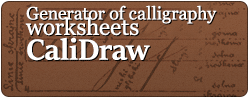Make Yourself an 18th-Century Ink for Your Own Needs
04-04-2025 | Author Emma | Categories: kaligrafia.info | Tagi: calligraphy tools, DIY, history, Inspirations | 💬 »In the 18th century, ink production, known then as “inkaust,” was a widely practiced skill, especially among those involved in writing and documentation. The old book “Sztuka Pisania w Trzech Rozdziałach” (“The Art of Writing in Three Chapters”) by Dominik Gabriel Szybiński from 1781 provides detailed recipes and processes for making ink. This blog post will explore these historical methods and offer modern interpretations of the recipes.
18th-Century Recipes and Processes for Making Ink
Basic Ingredients
Ink in the 18th century was primarily made from natural ingredients. The key components included:
- Oak galls: Rich in tannins, these were collected from oak trees, dried, and ground into powder.
- Iron sulfate (green vitriol): This reacted with the tannins to produce a dark color.
- Gum arabic: Used as a thickener and stabilizer to prevent ink from spreading on paper.
- Water: The primary solvent, sometimes supplemented with vinegar or wine for added stability.
Preparation Process
- Grinding and boiling: Oak galls were ground into a fine powder and boiled in water to extract tannins.
- Chemical reaction: Iron sulfate was added to the tannin-rich solution, resulting in a dark-colored ink.
- Thickening: Gum arabic was mixed into the solution to achieve the desired consistency.
Types of Ink
- Black ink: The most common type, used for everyday writing and official documents.
- Colored inks: Red ink was made with cochineal dye, while blue ink used indigo.

Modernized Recipes for Inks of Different Colors
Thanks to modern techniques, historical recipes can be recreated in a more accessible way. While some ingredients may seem unusual, in the age of the Internet, they can be ordered or made at home. For example, iron sulfate is a product commonly used in gardening. Iron sulfate crystals can also be grown independently using relatively simple ingredients; however, that would probably be a topic for a separate post (let us know in the comments if such an article would be interesting).
For ink pigments such as cochineal or indigo, you can also rely on online purchases or simply experiment in the spirit of 18th-century alchemists.
Black Ink
- Ingredients:
- 10 g oak galls (or powdered tannins)
- 5 g iron sulfate
- 2 g gum arabic
- 100 ml water
- Instructions:
- Grind oak galls into a fine powder.
- Boil water and add oak galls; simmer for about an hour.
- Let the mixture cool and strain it through cheesecloth.
- Add iron sulfate and gum arabic; stir until dissolved.
Red Ink
- Ingredients:
- 5 g cochineal (natural red dye)
- 5 ml vinegar
- 2 g gum arabic
- 100 ml water
- Instructions:
- Simmer cochineal with water and vinegar for about an hour.
- Strain the liquid and add gum arabic; mix thoroughly.
Blue Ink
- Ingredients:
- 5 g indigo powder
- A pinch of baking soda
- 2 g gum arabic
- 100 ml water
- Instructions:
- Dissolve indigo in water with baking soda to create a deep blue solution.
- Add gum arabic and mix well.
Conclusion
Ink-making in the 18th century required knowledge of chemistry and access to specific natural materials. By following these recipes, you can recreate high-quality inks that honor historical traditions while using modern conveniences. If you successfully make one of these inks, test it on our calligraphy worksheet generator and share your results! For full authenticity, consider crafting a quill pen. Good luck!



Leave your comment